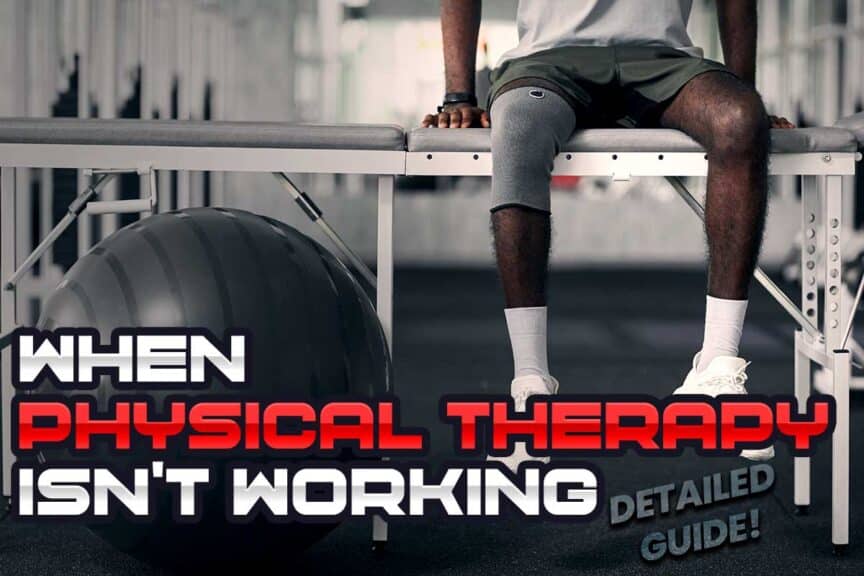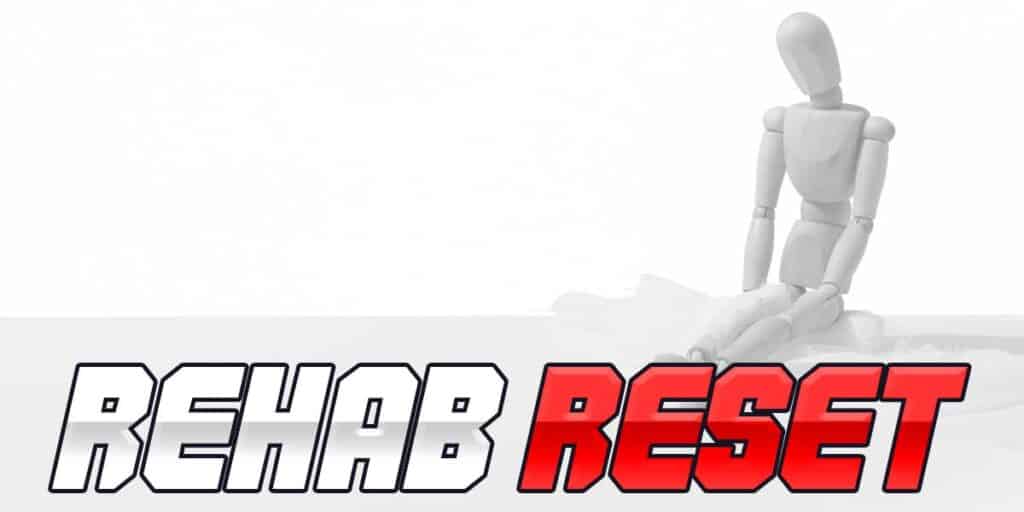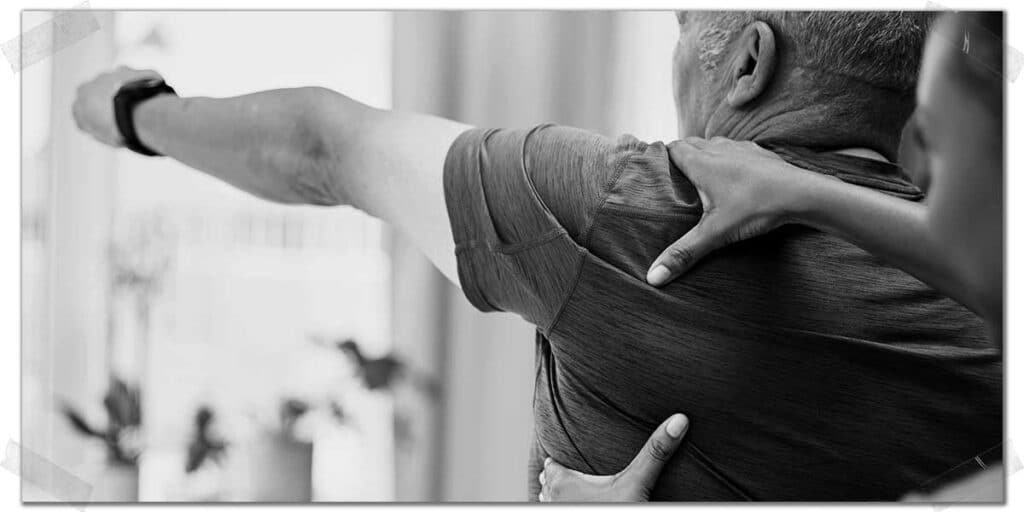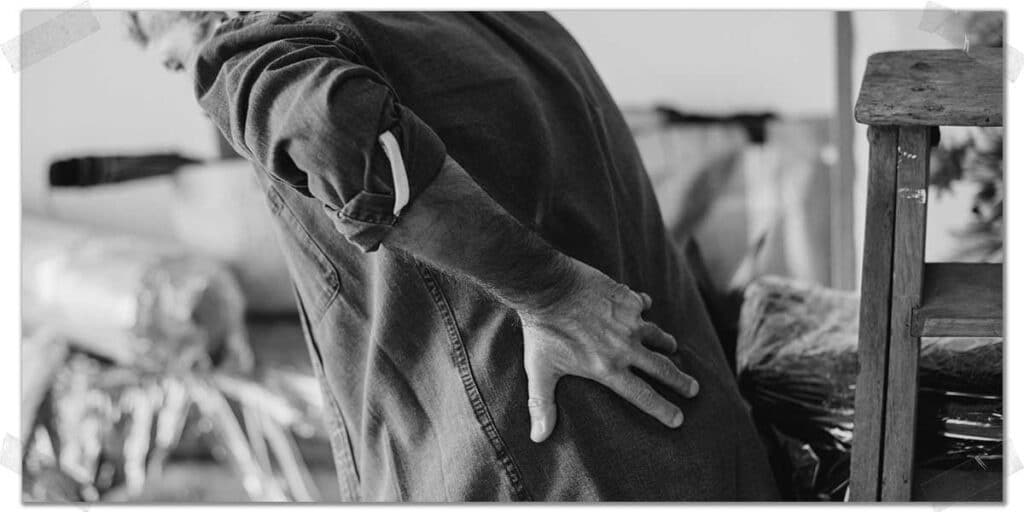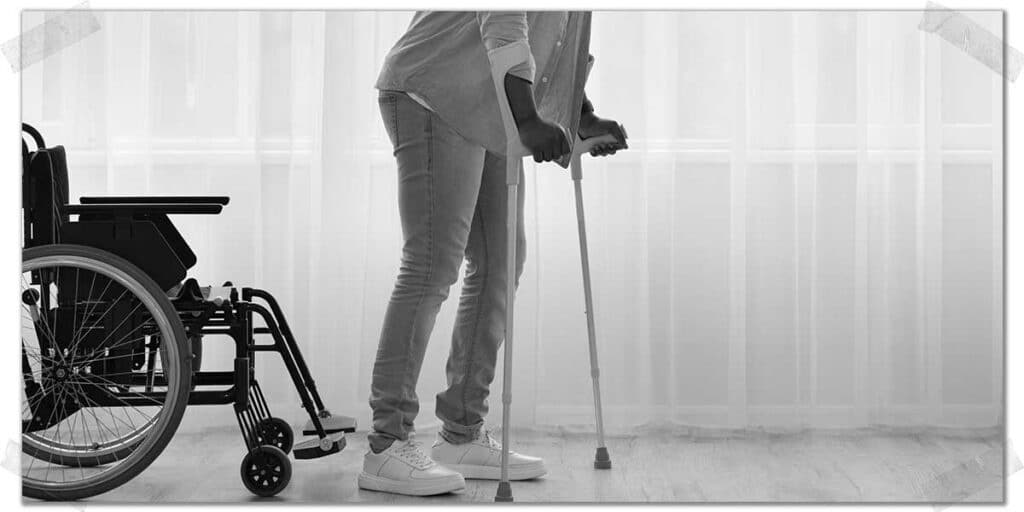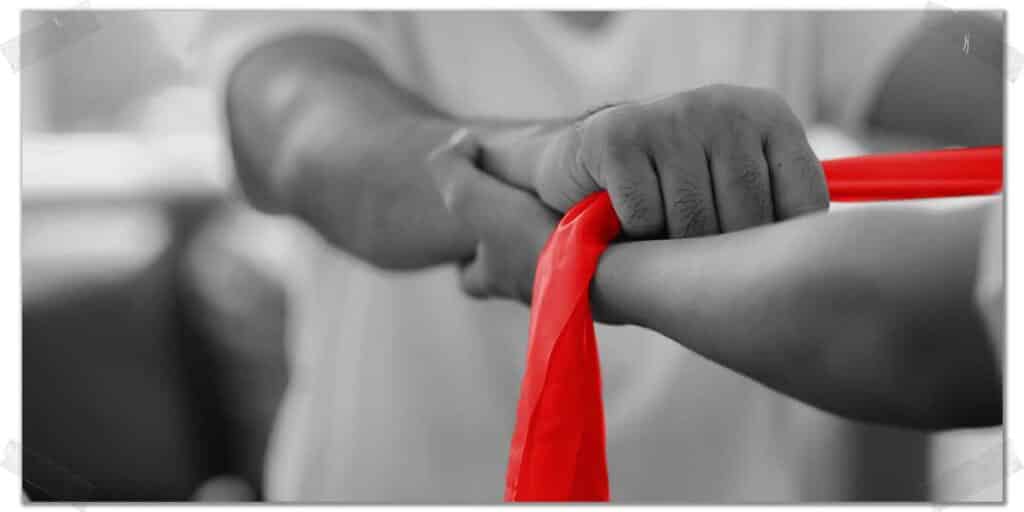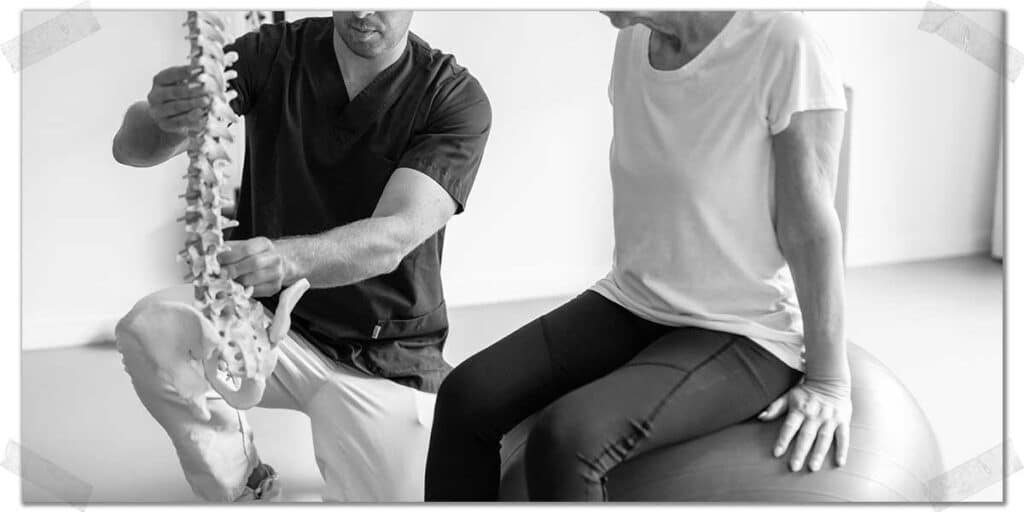Being in pain and being limited in your physical abilities is a horrible experience and one I wish no human being had to go through. That’s one of the many reasons why I became a physical therapist. And while it always makes my day to see people overcome their pain and physical limitations, there are times when progress is slower than expected or doesn’t occur at all.
If you’re struggling to make progress with your physical therapy, this article will provide a detailed walkthrough for troubleshooting your lack of improvement, providing critical insight that will hopefully provide clarity and confidence for your situation.
So, if you keep reading, you’ll learn how acquiring specific knowledge and acting upon it by taking targeted actions can be profoundly helpful for those who aren’t making much progress with their physical therapy and rehabilitation.
A small request: If you find this article to be helpful, or you appreciate any of the content on my site, please consider sharing it on social media and with your friends to help spread the word—it’s truly appreciated!
As I get going with this article, please remember that it’s impossible for me to write about physical therapy not working for every specific injury or a specific condition. Rather, the aim of this article is to provide concepts, strategies, and steps that individuals can take that work for any scenario in which a lack of rehabilitative progress is taking place.
So, what follows below will apply to any type of injury, condition, or dysfunction, but you will need to individualize any further actions or steps you take to meet your needs and overall condition (get your physical therapist to help you with this, if needed).
Knowledge: Everything Starts Here
As a physical therapist, there are many ways I can help others overcome their pain, heal from their injuries, and improve their functional abilities. I have a lot of skills and training to help achieve these tasks, and they are all very important to an optimal recovery process. But the starting point for ensuring effective rehab must absolutely begin with education pertaining to not only the issue at hand but what to expect throughout the recovery process.
Of all the ways physical therapists can help their patients, the absolute most important tool we have is educating our patients about all factors pertaining to their injury or condition. The backbone of effective physical therapy is the education we can provide our patients, and as such, it must always be the starting point in rehabilitation.
If rehabilitation is a journey, education about your injury or condition is the road map showing you how to get from your current state to your desired destination. Without this reference to chart your path forward, it becomes all too easy to take wrong turns, experience setbacks, or move in the wrong direction. When any or all of these situations arise, progress becomes minimal or nonexistent.
Related article: You’ll Get WAY More Out Of Your Physical Therapy With THESE Tips
I can’t stress enough the importance of being well-informed about your current injury, condition, and situation. The better your understanding of all things pertaining to your situation, the better your outcomes will be.
As you keep reading the three steps below within this section that pertain to the education of your condition and situation, know that they are foundational for ensuring you make progress with whatever it is that you’re up against.
The resources offered by the Neuro Orthopedic Institute (NOIgroup) and physio-pedia.com, among others, can be profoundly helpful for educating patients on injury, pain, and rehabilitation.
Step 1: Know your condition & diagnosis
Any uncertainty, lack of clarity, or confusion you have about your injury or condition needs to be addressed. Simple as that. (I’ll explain why in a moment.) This is not to say you need to become an expert on your injury or condition, but you do need a rudimentary understanding of its nature, including:
- Why this injury or issue occurred
- How extensive or severe the issue is (mild, moderate, extreme, etc.)
- The overall prognosis (expected outcome), including length of recovery
You are not required to figure out these critical pieces of information on your own. Any patient I treat, as an example, will get this information within my initial assessment and will be encouraged to ask any and all other questions they may have about what’s going on.
The less uncertainty a patient has about what’s causing their pain or dysfunction, the better their outcomes will be.
Any physical therapist worthy of your time will provide answers to any questions you may have, so don’t be afraid to ask. This is our job; we are here to educate and empower you on your path toward recovery. If your physical therapist isn’t willing to take the time to provide you with an education on what’s going on, find a new therapist.
Pro tip: A very helpful and reliable resource for understanding physical injuries and injury rehabilitation is Physio-pedia.com. I often encourage many of my patients to read the information on this site if their curious to learn as much as they possibly can about their injury or condition.
Step 2: Know your healing timelines
An accurate understanding and expectations are everything for optimal recovery. It’s easy to become frustrated when you don’t know how much work you’ll have to put into your recovery or how long it will take before you experience the improvements you’re looking for.
You can be taking all the right steps and doing everything right as you commit to your recovery, but if you’re not certain of your recovery and healing timelines, you may feel like you’re not making any (or enough) progress when in fact, you’re about to experience a notable breakthrough!
Much the same, all too often, I see patients who feel they are making minimal progress when, in fact, they are actually above the standard healing or recovery timelines for their condition! This is why having an understanding of healing and recovery timelines for your injury or condition is so vital to have!
Sadly, I’ve seen way too many people give up on their rehabilitation, thinking it wasn’t working, when they were doing everything right and only needed a bit more time before results were likely to become evident.
Plenty of injuries and conditions can take a few weeks of dedicated effort before perceptible progress (symptom reduction, strength improvement, etc.) is noted. This isn’t the case for every scenario and will, of course, depend on the extent or severity, along with other factors unique to the individual. Nonetheless, you might just be on the verge of getting that pain of yours under control or getting your strength back if you continue on a bit longer.
Related content:
Full recovery can take much longer than what many patients expect (or want to hear). It’s often difficult for me to inform my patients that their recovery will likely take longer than they expect it to. Again, this is where it’s important for your therapist to give you their best clinical prediction for how long the process will be, otherwise, it’s as if you’re set up for failure by thinking recovery will only take a couple of weeks when, in fact, it can take multiple months or longer.
Step 3: Understand your pain—Not all hurt equals harm
Pain is an incredibly interesting phenomenon—it can be horrible to experience but is necessary to experience; pain protects us and gets our attention to let us know something is wrong.
Naturally, we tend to think of all pain being harmful or a sign that bad things are taking place within the body. While this can often be the case, it may come as a surprise to hear that not all pain is harmful and, in fact, can signify that positive change is taking place within the body.
The scenarios and situations in which pain isn’t harmful or can signify positive change taking place within the body are, of course, highly individualized, so you’ll want to talk with your physical therapist regarding interpreting your pain or discomfort as you make your way through rehabilitation.
The goal of this article isn’t to give you an in-depth rundown on pain science but rather to help you to work with your physical therapist to better understand the nature of:
- What you’re currently feeling
- Why these painful or uncomfortable sensations are occurring
- What these sensations signify
Having a basic understanding of what your pain means and why it’s occurring can be quite anxiety-relieving and help stop the process of catastrophization (the thought process of always assuming the worst about a situation).
Powerful Resources for Understanding Your Pain
If you want an extremely reliable (i.e., world-class) resource on the latest findings and resources for interpreting and understanding your pain, I would highly advise you to check out the resources offered by the Neuro Orthopedic Institute Group (NOIgroup).
The resources offered by the NOIgroup are arguably the best out there when it comes to making sense of pain and gaining the upper hand on understanding why you’re feeling what it is that you’re feeling.
Knowledge is power, and when you gain a better understanding of what your pain means, you will be better positioned to make progress with your physical therapy and subsequent rehabilitation.
Actions: Producing Better Outcomes
Arming yourself with knowledge is the vital first step to take in troubleshooting your physical therapy and ensuring progress and ultimate success. But that knowledge is largely useless without being followed up by taking appropriate actions.
Again, taking action is something any physical therapist worthy of your time will help you out with. While the specific actions can vary greatly and will be different from one individual to the next, the overarching concepts that can be applied to any scenario will be the same and are discussed in the following subheadings.
Take an active role in your recovery
Physical therapy intervention consists of two categories in which treatment and recovery can be administered:
- Passive intervention/recovery
- Active intervention/recovery
Passive intervention or recovery refers to having a therapist administer treatment to the body or injured area without any activity required by the patient. This can include treatment modalities such as class IV laser therapy, extracorporeal shockwave therapy, pulsed radio frequency, and so on (these are just quick examples I’m listing, as they are interventions I frequently use with my patients).
Active interventions are treatment techniques or strategies where you, the patient, actively move, challenge, and stress your body in appropriate ways that produce therapeutic healing, such as pain reduction, strength improvement, movement enhancement, improved muscle endurance, and much more.
And here’s what’s essential to know: While passive treatment and interventions have a time and place for reducing pain, improving functional abilities, and so on, they should almost always be supplemented with active interventions that are appropriate for your injury or condition.
Again, there are a myriad of factors to consider here, but the overarching principle is that you, the patient, must have movements and exercises that appropriately stimulate and challenge the tissues (muscles, tendons, nerves, etc.) and structures (joints, lungs, heart, etc.) within your body which help to stimulate them towards better function and health.
Related article: How To Make Physical Therapy Fun | Kids | Teens | Adults (Expert Tips)
Making active intervention the backbone of therapeutic treatment is a principle that I believe to be paramount to achieving the best outcomes possible. Regardless of how simple, small, or basic these movements, exercises, and activities may be, they help to stimulate the body in ways that passive interventions often can’t.
Please, don’t get me wrong—passive interventions can absolutely be game-changers for improving an individual’s function and reducing their pain, and I am in no way saying they’re not beneficial. They most certainly can be (I use them on my patients all the time). But your long-term prognosis (projected outcome) will be MUCH better when you incorporate the appropriate physical exercises and movements into your rehabilitation regimen.
One of the powerful benefits of active recovery interventions is that they can most often be performed outside of the clinic as part of your home exercise program. This allows you to essentially treat your body multiple times per week without having to wait until the next time you’re back in the clinic.
Know what to avoid & respect your body
As mentioned earlier, doing all the right stuff to help your body heal, become stronger, and improve its functional abilities through active interventions (such as therapeutic exercise and certain passive interventions) is vital to making progress with your physical therapy. But there’s another critical component you need to adhere to:
As you go through your physical therapy treatment and recovery, you need to ensure you avoid doing the wrong things—the things that can impede your progress, slow your healing, or even make your injury or condition worse.
The most optimized and effective rehabilitative treatment and regimen won’t amount to much if you’re constantly performing activities or tasks that are detrimental to your body’s recovery.
To be clear, this isn’t a license to sit down and do nothing at all. Rather, it’s permission to ask your physical therapist or similar healthcare professional to help you understand and be aware of tasks, activities, positions, etc., that should be avoided or performed with caution throughout various stages of your recovery.
Again, it’s not up to you to figure out what you should stay away from throughout each phase of your rehabilitation all by yourself; your physical therapist should make it a priority to help educate you on these factors.
Knowing what the wrong types of tasks or activities that are detrimental to your recovery are can often be a bit tricky to figure out for patients; pain is only one indicator (albeit an extremely important one) that your body might not appreciate a task, activity or movement you’re performing.
A very common example: Poor movement mechanics (known as motor control) or poor awareness of how we move our body (known as sensorimotor awareness) are common issues that can cause recovery to slow down—or even stall out—due to abnormal stress, strain, or stretch being placed on irritated or unhealthy tissues within the body (oftentimes without being perceived by the patient).
I would encourage anyone who feels their physical therapy isn’t working to chat with their therapist to see if there may be any factors in their daily life (activities, ways that they’re moving, etc.) that are hindering their progress toward recovery.
Celebrate the little victories throughout your recovery
When the road to recovery is one that you know will be long and arduous, it’s important to adopt a mindset that celebrates every little victory along the way.
It’s all too easy to become mentally fixated on what’s not improving or how much more time and effort will be required to get back to improved health and wellness. And if you’re solely focused on the challenges and difficulties, it’s incredibly easy to become disheartened and give up on your physical therapy altogether; it just feels too overwhelming and, ultimately, pointless.
“Making a conscious effort to be mindful of and acknowledge (i.e., celebrate) small, positive changes helps to empower us in ways that keep us on track by sticking to our physical therapy regimen.”
To combat this issue, one strategy I frequently incorporate into my sessions with patients who have a long road ahead or are feeling helpless or disheartened with where they’re physically at is to make a deliberate effort to celebrate every little victory they experience as they go through their physical rehabilitation, no matter how small or seemingly insignificant those victories may be.
Making a conscious effort to be mindful of and acknowledge (i.e., celebrate) small, positive changes helps to empower us in ways that keep us on track by sticking to our physical therapy regimen. It really can be a mental game-changer for helping you to regain a sense of control over your situation.
Pro tip: It takes effort and energy to celebrate progress, so this is very much a behavioural action that requires effort on your part; it is by no means a passive intervention.
As a quick example or two: Pain intensity went down from a seven to a six? Celebrate this! Managed to complete a couple of extra repetitions on one of your home exercises! Celebrate this! Able to lift your arm above your head for the first time since you’re injury? Celebrate this!
Obviously, I could go on and on with examples and scenarios when little achievements and notable bits of progress should be celebrated, but I’m sure you get the concept.
Learning to foster the behavioural habit of looking for and appreciating small, incremental bits of progress has made a profound difference for many of the patients I treat and rehabilitate within the clinic, and I have full confidence it can do the same for you.
Get a second opinion on your injury, condition, or prognosis
This action is reserved for the situations and scenarios where you or your therapist feel it’s worth getting another professional’s insight towards any factors that warrant consideration for an additional practitioner to offer their expertise and professional insight into your situation.
There are times when you may wish to take this action, and there are times when your therapist may wish to do the same. It’s certainly not unheard of for me to ask my patients if they’d like a second opinion from one of my colleagues if I feel that progress is occurring at a slower rate than expected or if I feel that patient may be in better hands with a colleague with more expertise for their condition than I myself have.
Remember: There is no room for ego in the healthcare professions; a good therapist will be able to set their ego aside in the name of ensuring everything possible is being done to help you in your recovery as much as possible.
Reasons for getting a second opinion can include (but certainly aren’t limited to):
- Ensuring the pathoanatomical diagnosis you’ve been given is correct
- Ensuring no critical findings have been missed in the assessment
- Receiving an evaluation from a specialist
There might also be times when you feel that you’ll be in better hands with another therapist altogether. Should this be the case, don’t be afraid to speak up. While it’s important that you respect the expertise of the physical therapist you’re working with and understand that initial progress can take a handful of sessions before becoming evident, switching (if possible) to another therapist is certainly warranted for situations where:
- Your therapist refuses to re-evaluate your condition or try an alternative treatment intervention despite any progress being absent over numerous sessions or treatments;
- You feel that progress has been minimal or absent for a prolonged period of time despite several treatments;
- You feel your therapist is not entirely or truly invested in your wellbeing and your pursuits toward recovery.
Related article: Pro Advice: Find The Best Physical Therapist For You With THESE Tips
To be clear, this is not in any way suggesting you jump ship after one or two treatments; unless your therapist is outright unprofessional or condescending to you, it’s likely in your best interest to hang in there for a handful of treatment sessions. Still, if you feel that you’ll be in better hands with another therapist, making a switch is always an option.
Focus on other domains of health & wellness
Oftentimes, in the world of physical rehabilitation, we forget (both the patient and the practitioner) about the importance of looking after the other domains of our lives that are associated with health and wellness.
Most models out there acknowledge five distinct domains of human health and wellness. These domains are:
- Physical health
- Emotional/mental health
- Social health
- Intellectual health
- Spiritual health
It’s all too common in the world of physical rehabilitation that we neglect the other domains of health and wellness outside of the physical realm. The epitome of human health and wellness occurs when all five of these domains are balanced and given the equal and proper attention each one deserves.
Focusing on each domain does wonders for the body. When physical injury and dysfunction are present, they can take a toll on the other domains of our wellbeing; we can’t partake in our activities with our friends (affecting our social health); we feel frustrated that our recovery isn’t happening at a quicker rate (affecting our emotional health), and so on. At this point, the domains are no longer operating equally or in harmony, and it can lead to physical stress on the body, which can adversely affect injury recovery and overall physical wellbeing.
It makes perfect sense: physical stress can lead to a bigger uphill battle for the body to have to deal with. Our sleep can be negatively impacted, our digestion can get messed up, our muscles stay chronically tense, and so on.
Keeping every domain in check is always a priority, and even more so when our physical recovery seems to be ineffective, prolonged, or incredibly slow. Improving any domains that need help will only serve to make the needed physical recovery your body requires to be easier to attain.
So, take the time to check in on yourself with how these other domains of your wellbeing are holding up. If any of them feel like they’re out of balance, give them the attention they need to improve.
The result can be remarkably improved physical health. It’s surprising to many (but well-known in the scientific world) how the body can heal more effectively when our emotional health is doing well or when we tap into our spiritual side and listen to the still small voice within us. Yes, focus on the physical rehabilitation of your body, but focus on the maintenance (and even rehabilitation) of the other domains in your life as well.
Final thoughts
If your physical therapy isn’t working or doesn’t seem to be helpful or beneficial, take a deep breath. Oftentimes it’s a matter of recalibrating things; take a step back, and make sure you have a clear picture of everything—the process, the expectations, and the requirements going forward.
This is a process, and one I wish you the best results with. Breathe deep and keep fighting the good fight.
Frequently Asked Questions
I’d like to be as helpful as possible within this article, so I’ve included a few brief answers to some commonly asked questions people often have when it comes to physical therapy helping them get out of pain or improving their functional abilities.

Hi! I’m Jim Wittstrom, PT, DPT, CSCS, Pn1.
I am a physical therapist who is passionate about all things pertaining to strength & conditioning, human movement, injury prevention and rehabilitation. I created StrengthResurgence.com in order to help others become stronger and healthier. I also love helping aspiring students and therapists fulfill their dreams of becoming successful in school and within their clinical PT practice. Thanks for checking out my site!

